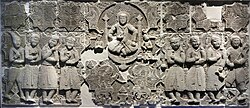
Back Chasare Afrikaans Chasaren ALS የኻዛር መንግሥት Amharic Gazaros AN خزر Arabic خزر ARZ Jázaros AST Хазарал AV Xəzərlər Azerbaijani خزرلر AZB
Khazar Khaganate | |||||||||||||||||||||
|---|---|---|---|---|---|---|---|---|---|---|---|---|---|---|---|---|---|---|---|---|---|
| c. 650–969 | |||||||||||||||||||||
 Khazar Khaganate, 650–850 | |||||||||||||||||||||
| Status | Khaganate | ||||||||||||||||||||
| Capital | |||||||||||||||||||||
| Common languages | |||||||||||||||||||||
| Religion | |||||||||||||||||||||
| Qaghan | |||||||||||||||||||||
• c. 650 | Irbis | ||||||||||||||||||||
• 8th century | Bulan | ||||||||||||||||||||
• 9th century | Obadiah | ||||||||||||||||||||
• 9th century | Zachariah | ||||||||||||||||||||
• 9th century | Manasseh | ||||||||||||||||||||
• 9th century | Benjamin | ||||||||||||||||||||
• 10th century | Aaron | ||||||||||||||||||||
• 10th century | Joseph | ||||||||||||||||||||
• 10th century | David | ||||||||||||||||||||
• 11th century | Georgios | ||||||||||||||||||||
| Historical era | Middle Ages | ||||||||||||||||||||
• Established | c. 650 | ||||||||||||||||||||
| 969 | |||||||||||||||||||||
| Area | |||||||||||||||||||||
| 850 est.[4] | 3,000,000 km2 (1,200,000 sq mi) | ||||||||||||||||||||
| 900 est.[5] | 1,000,000 km2 (390,000 sq mi) | ||||||||||||||||||||
| Currency | Yarmaq | ||||||||||||||||||||
| |||||||||||||||||||||
| History of the Turkic peoples pre–14th century |
|---|
 |
The Khazars[a] (/ˈxɑːzɑːrz/) or Khazar Turks[10] were a semi nomadic Turkic people who, in the late 6th century CE, established a major commercial empire covering the southeastern section of modern European Russia, southern Ukraine, Crimea, and Kazakhstan.[11] They created what, for its duration, was the most powerful polity to emerge from the break-up of the Western Turkic Khaganate.[12]
Positioned along critical Eurasian trade routes, Khazars functioned as a key intermediary in Silk Road commerce and dominated the trade routes by linking China, the Middle East, and Kievan Rus'. For some three centuries it became one of the most influential trading empires of the early medieval period until its decline in the 10th century.[13][14][15]
Khazaria long served as a buffer state between Byzantine Empire, steppe nomads, and the Ummayad and Abbasid Caliphates. It once helped Byzantium fight the Sasanian Empire, but around 900, Byzantium turned against Khazaria, backing the Alans to weaken its control over Crimea and the Caucasus. Byzantium then allied with Kievan Rus’, hoping to convert them to Eastern Christianity.[16] Between 965–969, Sviatoslav I of Kiev conquered Khazaria’s capital, Atil, ending its independence.
Origin and nature of Khazars is closely bound with theories of their language. Khazar language is a Turkic language that's hard to be classify since few words from Khazar language survived. Khazar Empire's society was polyglot and polyethnic, including Tengrism, Judaism, Christianity, and Islam. Some Khazars (namely Kabars) joined the ancient Hungarians in the 9th century. Their ruling elite reportedly converted to Judaism in the 8th century, but this elite conversion believed to have not widespread in society.[17] In 965, relation and alliance with Arabs made Khazarians and ruling dynasty to convert Islam.[18]
After Khazaria fell, many nations claimed to have Khazar lineage and Turkic origin.[19][20][21] In late 19th century a group of scholars claimed that Ashkenazi Jews in Europe are descended from Khazars. Back then theory politically supported by Nazi German intellectuals to legitimize war crimes and the Holocaust.[22] In modern academia theory rarely finds a mention.[23][17] and generally associated with antisemitism[24] and anti-Zionism.[25]
In Oghuz Turkic languages, the Caspian Sea is still named the "Khazar Sea", an enduring legacy of the medieval Khazar state.
- ^ a b c Golden 2006, p. 91.
- ^ Wexler 1996, p. 50.
- ^ Brook 2010, p. 107.
- ^ Turchin, Adams & Hall 2006, p. 222.
- ^ Taagepera 1997, p. 496.
- ^ Luttwak 2009, p. 152.
- ^ Meserve 2009, p. 294, n. 164.
- ^ Petrukhin 2007, p. 255.
- ^ Golden 2018, p. 294.
- ^ • Golden, Peter (1997). Theophanes, The Chronicle of Theophanes Confessor translated by Cyril Mango and Roger Scott. p. 446.
During his [Byzantine emperor Heraclius] stay there [in Lazica], he invited the eastern Turks, who are called Chazars, to become his allies.
• Golden, Peter. Khazar Studies. pp. 57, 58.The Arabic writer al-Masudi in Kitab at-Tanbih wrote '...the Khazars... are a tribe of the Turks.'
• Golden, Peter. Khazar Studies. p. 58.T'ang-shu reads: "K'o-sa [Khazars]... belong to the stock of the Turks."
- ^ Encyclopedia Britannica: Khazar 2020.
- ^ Sneath 2007, p. 25.
- ^ Noonan 1999, p. 493.
- ^ Golden 2011a, p. 65.
- ^ Noonan 1999, p. 498.
- ^ Noonan 1999, pp. 499, 502–503.
- ^ a b Behar et al. 2013, pp. 859–900.
- ^ Petrukhin 2007, p. 263.
- ^ Kizilov 2009, p. 335.
- ^ Patai & Patai 1989, p. 73.
- ^ Wexler 1987, p. 70.
- ^ Diner, Dan (2006). Jüdische Geschichte als allgemeine Geschichte: Festschrift für Dan Diner zum 60. Geburtstag. Vandenhoeck & Ruprecht. pp. 212, 231. ISBN 978-3-525-36288-4.
- ^ Wexler 2002, p. 536.
- ^ Davies 1992, p. 242.
- ^ Vogt 1975.
Cite error: There are <ref group=note> tags on this page, but the references will not show without a {{reflist|group=note}} template (see the help page).
Cite error: There are <ref group=lower-alpha> tags or {{efn}} templates on this page, but the references will not show without a {{reflist|group=lower-alpha}} template or {{notelist}} template (see the help page).
© MMXXIII Rich X Search. We shall prevail. All rights reserved. Rich X Search